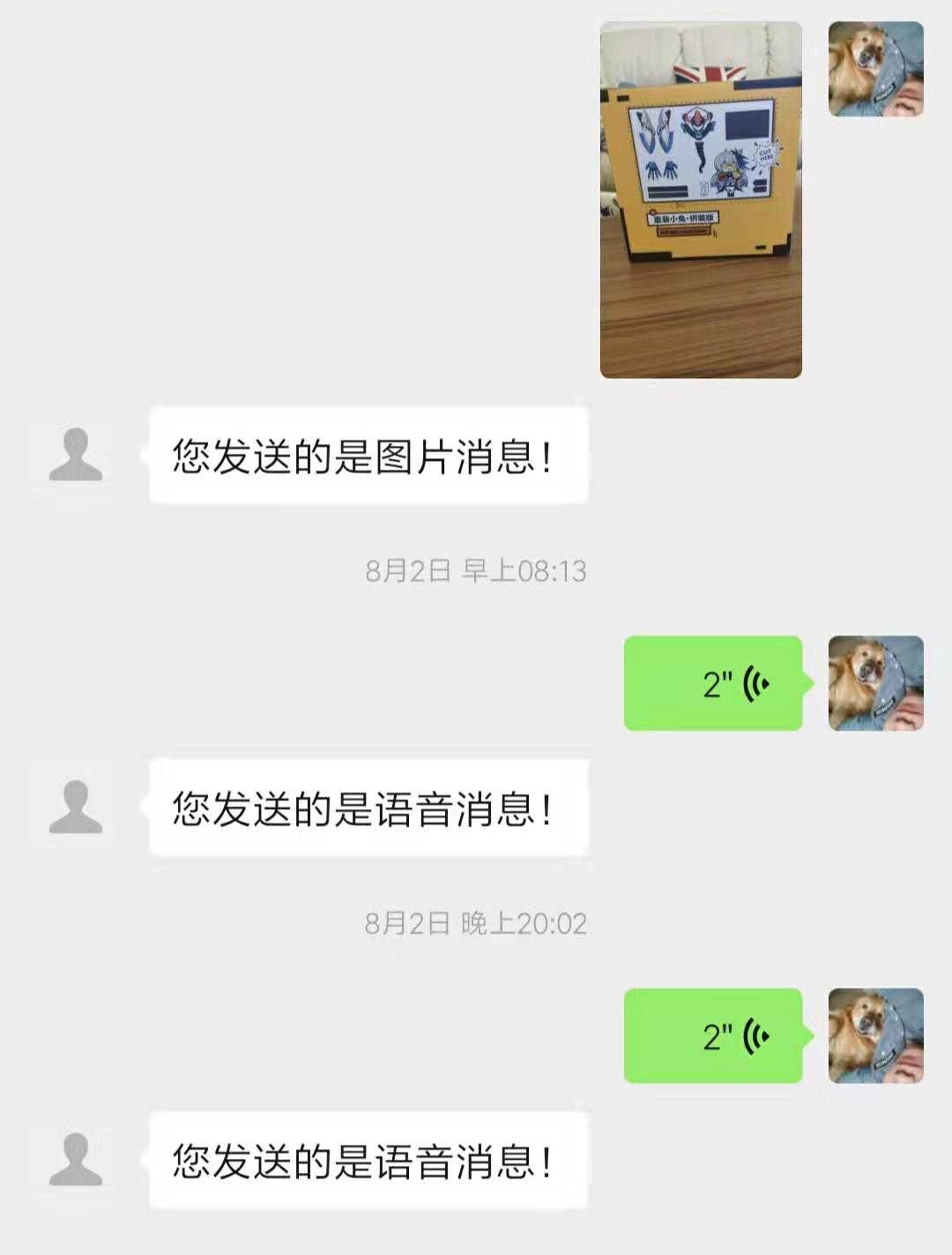前言
这几天在尝试搞一个微信公众号,然后用家里的树莓派做服务器.
然后通过frp将树莓派映射到我的阿里云服务器
先尝试了直接写一个springboot web demo 做接口,大概能够将用户发送的信息返回
然后,把微信接口做个成 java 的单独模块吧
这样如果有机会接触微信公众号开发的话,还可以直接用(大概)
由于我只有资格申请订阅号,功能比较少,所以也只实现了一部分东西.
- 微信接入
- 用户消息回复
从扩展功能上来看,后续还需要:
- 微信上传/下载多媒体文件
- 自定义菜单管理
- 用户绑定
- 收付款
- etc.
有些需要一个界面才方便使用,于是想起了Swagger-UI
Swagger-UI
一个将Swagger API Spec以HTML页面展现出来的模块
它是一个带web管理页面的starter
所以
做成一个springboot starter
最近也在尝试对springboot 进行更多了解
想像中,项目只需要引入微信starter就能够直接进行业务开发
以下文字包含这些:
- 创建自定义
springboot starter - 根据需要配置
starter - 从springboot项目引入并使用
微信starter
PS:由于个人习惯使用Groovy作为开发语言,所以内容中会包含部分与Groovy相关代码.当做java读就行了
创建自定义springboot starter
1.新建Maven项目,并添加依赖
创建一个Maven空白项目
并添加如下依赖pom.xml
<?xml version="1.0" encoding="UTF-8"?>
<project xmlns="http://maven.apache.org/POM/4.0.0"
xmlns:xsi="http://www.w3.org/2001/XMLSchema-instance"
xsi:schemaLocation="http://maven.apache.org/POM/4.0.0 http://maven.apache.org/xsd/maven-4.0.0.xsd">
<modelVersion>4.0.0</modelVersion>
<groupId>vip.hoody</groupId>
<artifactId>hoody-wechat-springboot-starter</artifactId>
<version>1.0-SNAPSHOT</version>
<dependencies>
<!-- 想要让自定义配置项有提示,导入这个包,在项目编译后会生成元数据,同样是在META-INF目录下-->
<!-- 会自动生成spring-configuration-metadata.json文件。-->
<dependency>
<groupId>org.springframework.boot</groupId>
<artifactId>spring-boot-configuration-processor</artifactId>
<version>2.1.6.RELEASE</version>
</dependency>
<!--spring mvc 便于添加web-->
<dependency>
<groupId>org.springframework.boot</groupId>
<artifactId>spring-boot-starter-web</artifactId>
</dependency>
<!--Groovy混合开发-->
<dependency>
<groupId>org.codehaus.groovy</groupId>
<artifactId>groovy-all</artifactId>
<version>2.5.7</version>
<type>pom</type>
</dependency>
</dependencies>
<!--根据springboot 依赖齐版本-->
<dependencyManagement>
<dependencies>
<dependency>
<groupId>org.springframework.boot</groupId>
<artifactId>spring-boot-dependencies</artifactId>
<version>2.1.6.RELEASE</version>
<type>pom</type>
<scope>import</scope>
</dependency>
</dependencies>
</dependencyManagement>
<build>
<plugins>
<plugin>
<groupId>org.springframework.boot</groupId>
<artifactId>spring-boot-maven-plugin</artifactId>
</plugin>
<!--groovy 编译依赖-->
<plugin>
<groupId>org.codehaus.gmavenplus</groupId>
<artifactId>gmavenplus-plugin</artifactId>
<version>1.6.3</version>
<executions>
<execution>
<goals>
<goal>addSources</goal>
<goal>addTestSources</goal>
<goal>generateStubs</goal>
<goal>compile</goal>
<goal>generateTestStubs</goal>
<goal>compileTests</goal>
<goal>removeStubs</goal>
<goal>removeTestStubs</goal>
</goals>
</execution>
</executions>
</plugin>
</plugins>
</build>
</project>2.创建配置类
- 指定将包
vip.hoody.wechat添加入spring bean 扫描范围 - 可使用Spring注解进行装配
StarterConfiguration.groovy
package vip.hoody.wechat.config
import org.springframework.context.annotation.ComponentScan
import org.springframework.context.annotation.Configuration
@Configuration
/** 指定扫描包路径 */
@ComponentScan(basePackages = "vip.hoody.wechat")
class StarterConfiguration {
}
3.创建微信服务处理控制器 WechatController
/src/main/groovy/vip/hoody/wechat/controller/WecahtController.groovy
package vip.hoody.wechat.controller
import org.springframework.beans.factory.annotation.Autowired
import org.springframework.web.bind.annotation.GetMapping
import org.springframework.web.bind.annotation.PostMapping
import org.springframework.web.bind.annotation.RequestParam
import org.springframework.web.bind.annotation.RestController
import vip.hoody.wechat.config.WechatConfig
import vip.hoody.wechat.service.WeChatService
import vip.hoody.wechat.utils.SignCheck
import javax.servlet.http.HttpServletRequest
@RestController
class WeChatController {
@Autowired
WechatConfig config
@Autowired
private WeChatService weChatService
/**
* 处理微信服务器发来的get请求,进行签名的验证
*
* signature 微信端发来的签名
* timestamp 微信端发来的时间戳
* nonce 微信端发来的随机字符串
* echostr 微信端发来的验证字符串
*/
@GetMapping('${hoody.wechat.url: wechat}')
String handleWeChat(@RequestParam("signature") String signature,
@RequestParam("timestamp") String timestamp,
@RequestParam("nonce") String nonce,
@RequestParam("echostr") String echostr) {
boolean isTrust = SignCheck.checkSignature(config.TOKEN, signature, timestamp, nonce)
if (isTrust) {
return echostr
} else {
return null
}
}
/**
* 监听微信消息,返回符合要求的xml
* @param request
* @return
*/
@PostMapping(value = '${hoody.wechat.url}', produces = "application/xml;charset=UTF-8")
String handleUserMsg(HttpServletRequest request) {
return weChatService.processRequest(request.getInputStream())
}
}3.创建服务类WeChatService
/src/main/groovy/vip/hoody/wechat/servicie/WechatService.groovy
package vip.hoody.wechat.service
import org.slf4j.Logger
import org.slf4j.LoggerFactory
import org.springframework.beans.factory.annotation.Autowired
import org.springframework.stereotype.Service
import vip.hoody.wechat.IWechatHandler
import vip.hoody.wechat.WeChatFactory
import vip.hoody.wechat.bean.received.ReceivedBaseMsg
import vip.hoody.wechat.bean.reply.ReplyBaseMsg
@Service
class WeChatService {
private static final Logger log = LoggerFactory.getLogger(this.class)
/**
* 处理器接口,使用项目实现接口
*/
@Autowired
private IWechatHandler wechatHandler
/**
* 处理收到的微信信息
* @param xml 文本流
* @return 响应xml文本,符合wechat接口
*/
String processRequest(InputStream xml) {
ReceivedBaseMsg userMsg = WeChatFactory.getWechatReceivedMsg(xml)
try {
ReplyBaseMsg replyBaseMsg = wechatHandler.handle(userMsg)
return replyBaseMsg.toXml()
} catch (Exception e) {
log.warn("处理用户微信消息出现异常", e)
return WeChatFactory.createTextReply(userMsg, "处理用户微信消息出现异常").toXml()
}
}
}4.消息处理接口
将接口实现后,注入spring处理用户发送的微信消息
/src/main/groovy/vip/hoody/wechat/IWechatHandler.java
package vip.hoody.wechat;
import vip.hoody.wechat.bean.event.EventBaseMsg;
import vip.hoody.wechat.bean.received.*;
import vip.hoody.wechat.bean.reply.ReplyBaseMsg;
/**
* 消息处理接口
* 实现接口,返回消息对象
*/
public interface IWechatHandler {
ReplyBaseMsg handle(ReceivedTextMsg msg);
ReplyBaseMsg handle(ReceivedImageMsg msg);
ReplyBaseMsg handle(ReceivedLinkMsg msg);
ReplyBaseMsg handle(ReceivedLocationMsg msg);
ReplyBaseMsg handle(ReceivedShortVideoMsg msg);
ReplyBaseMsg handle(ReceivedVideoMsg msg);
ReplyBaseMsg handle(ReceivedVoiceMsg msg);
ReplyBaseMsg handle(EventBaseMsg msg);
}
根据需要配置starter
参考程序羊-SpringBoot 应用程序启动过程探秘
Spring Boot自动注入的奥秘就来源于 Spring Boot应用在启动过程中会通过 SpringFactoriesLoader 加载所有 META-INF/spring.factories 文件,通过一系列的处理流程最终将 spring.factories 文件中的定义的各种 beans 装载入 ApplicationContext容器。
配置META-INF/spring.factories
创建文件,指定Springboot启动的时候扫描配置类,并加载bean
META-INF/spring.factories
org.springframework.boot.autoconfigure.EnableAutoConfiguration=vip.hoody.wechat.config.StarterConfiguration从springboot项目引入并使用微信starter
1.创建Springboot项目并引入微信starter
pom.xml
<dependency>
<groupId>vip.hoody</groupId>
<artifactId>hoody-wechat-springboot-starter</artifactId>
<version>1.0-SNAPSHOT</version>
</dependency>2.添加微信开发者信息
application.yml
#微信开发者信息
hoody:
wechat:
app-id: 'your appid'
app-secret: 'your appSecret'
token-rate: 7200000 #(ms) access_token refreash rate(default:7200000)
mapping3.实现vip.hoody.wechat.IWechatHandler接口
实现接口,响应收到的微信信息WechatHandlerImpl.java
public class WechatMsgHandler implements IWechatHandler {
@Override
public ReplyBaseMsg handle(ReceivedTextMsg msg) {
return new ReplyTextMsg(msg.fromUserName, msg.toUserName, new Date().getTime().toString(), "你在发是:图片信息");
}
@Override
public ReplyBaseMsg handle(ReceivedImageMsg msg) {
return new ReplyTextMsg(msg.fromUserName, msg.toUserName, new Date().getTime().toString(), "你在发是:图片信息");
}
@Override
public ReplyBaseMsg handle(ReceivedLinkMsg msg) {
return new ReplyTextMsg(msg.fromUserName, msg.toUserName, new Date().getTime().toString(), "你在发是:图链接息");
}
@Override
public ReplyBaseMsg handle(ReceivedLocationMsg msg) {
return new ReplyTextMsg(msg.fromUserName, msg.toUserName, new Date().getTime().toString(), "你在发是:定位信息");
}
@Override
public ReplyBaseMsg handle(ReceivedShortVideoMsg msg) {
return new ReplyTextMsg(msg.fromUserName, msg.toUserName, new Date().getTime().toString(), "你在发是:小视频信息");
}
@Override
public ReplyBaseMsg handle(ReceivedVideoMsg msg) {
return new ReplyTextMsg(msg.fromUserName, msg.toUserName, new Date().getTime().toString(), "你在发是:视频信息");
}
@Override
public ReplyBaseMsg handle(ReceivedVoiceMsg msg) {
return new ReplyTextMsg(msg.fromUserName, msg.toUserName, new Date().getTime().toString(), "你在发是:音频信息");
}
@Override
public ReplyBaseMsg handle(EventBaseMsg msg) {
return new ReplyTextMsg(msg.fromUserName, msg.toUserName, new Date().getTime().toString(), "你在发是:图片信息");
}
}4.返回信息给用户
所有返回信息继承ReplyBaseMsg,
可通过WeChatFactory创建返回信息
后续
这里写的比较杂,现在也才弄完一部分
随着对Springboot的深入,后续会单独出一个关于Springboot stater的介绍.